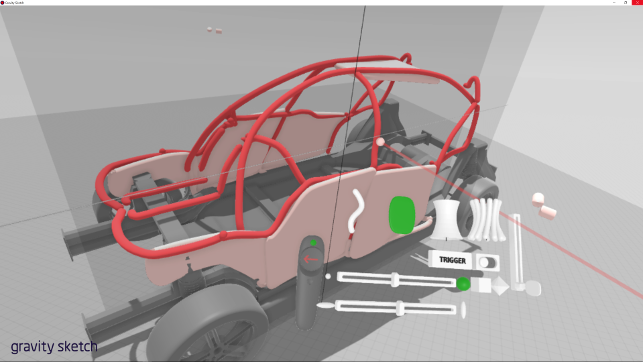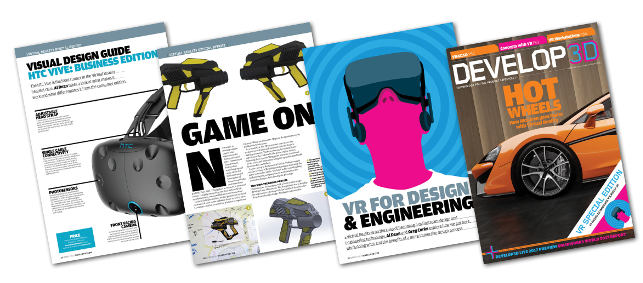The idea of creating geometry inside a VR environment is something that all of us dream about — usually more often after watching Iron Man for the upteenth time. There’s something infinitely attractive about waving your hands about, having geometry appear in mid-air, as if by magic.

Gravity Sketch lets you create in 3D space, at scale, like very little else out there. And it’s all hard geometry too
The reality is that VR isn’t there yet, but some teams are already exploring what happens when you combine the immersive nature of VR with motion tracked headsets and input devices. One such organisation is Gravity Sketch.
Those that visited DEVELOP3D LIVE last year (or caught the stream), will have seen founder, Oluwaseyi Sosanya, talking about the team’s work on iPad based solutions for freeform design.
That same team has now released, to public Beta test, Gravity Sketch VR and this steps things up a notch or two in terms of both interactivity and impressiveness.
While it’s way too early to draw conclusions on where the product is heading, I felt it was worth discussing where things are at now and see what sort of potential there is and how that might integrate into the design process.
Similarly to TiltBrush, Gravity Sketch works with the HTC Vive (though I’m sure they’ll expand this to work with the Oculus Rift eventually). You get the Beta through gravitysketch.com/beta.
Once installed and set-up, you fire it up, put on your headset and make sure your controllers are charged. You’re presented with a blank environment in which to work.
Gravity Sketch works with the idea that you’re creating solid geometry, rather than sketch or wire-frames. In your left hand, you have palette which gives a number of entities you sketch with.
There’s a range here, from simple pipe like forms (whose thickness you can control), to a number of more intelligent tools that combine both hands to control their form.
Essentially, the left hand trigger creates the geometry at the tip of the controller — think painting with geometry in mid-air.
Additionally, there are a number of primitives you can throw into the scene (a torso, a head, a car chassis amongst others) and even a set of tools to restrict the plane in which you can sketch — essentially, you place the plane with one hand (typically, the left), then draw or model on it with the other. This lets you nail things down to a much closer degree. Colour can be adjusted, so if you want to differentiate things, you can.
There’s also a mirror plane mode, so if you want to scheme something out and save time, you can, as the geometry is automatically mirrored across the plane.
In terms of output, images can be captured of your models, they can be passed around and if you want to, they can be output as OBJ fi les or uploaded to SketchFab.
Gravity Sketch is an interesting take on Modelling in VR — it’s clear that the team is thinking about design rather than consumer level play. The simple fact that you can model something up, however roughly, and see it at scale, is very interesting.
Now, it’ll rarely be the case that this geometry is anything other than a concept model (it’s too low res and a bit rough and ready — but that is perhaps part of the attraction). You can think in 3D space, quickly rough out shapes, ideas and concepts at a life-size scale.
That said, with a little fine tuning, perhaps some import options for primitives, it could really develop into something that’s not only fun (and it is, without a doubt), but also something that could really start to add a new element to creativity.
It also has potential as a design review, mark-up and collaboration platform as well. If you have even the most passing interest in VR for design, it’s certainly one to keep an eye on.
This article is part of a DEVELOP3D Special Report into Virtual Reality (VR) for design, engineering and manufacturing, which takes an in-depth look at the latest developments in software and hardware and what you need to get up and running.
Everything is for a reason How McLaren Automotive unleashes VR to create faster cars with more attention to detail
Quick guide: VR enabled applications A list of what’s out there now or coming soon
Virtual Reality challenges & future Six industry thought leader’s views on the future of VR
HTC Vive: Getting up and running Our experience of working with HTC Vive and how to avoid common mistakes
Workstations & GPUs for VR A back to basics guide to buying hardware for Virtual Reality
The future of immersive engineering Virtual Reality (VR) is the current hot topic, but Augmented Reality (AR) and Mixed Reality (MR) is on its way. We take a look at where things are heading
Game on Amalgam creates game controllers for Holovis
VRED Pro 2017 & VR The latest release adds greater support for the HTC Vive and Oculus Rift tools
Virtalis VR4CAD Offering expertise in VR at a much more affordable level
ESI Group IC.IDO 11 ESI’s IC.ID0 is one of the most advanced Digital Mock Up tools available. With its addition of Vive support, we take a look at what the system is capable of and how it can benefit engineering
Google Tiltbrush A system for VR creativity that’s both cheap and capable
Oculus Medium A good contender for design experimentation
Amari Magnetar V25 This stylish workstation has been specifically designed for VR. But despite its slimsline chassis, you can still cram in incredible processing power
Nvidia Quadro P2000/P4000 Nvidia is changing the landscape of professional 3D graphics with a new family of Pascal Quadro GPUs, including a single slot ‘VR Ready’ card.

To read all the articles, as they appeared in DEVELOP3D Magazine, you can download the March Edition here.
| Product | GravitySketch Beta |
|---|---|
| Company name | GravitySketch |
| Price | In Beta |






